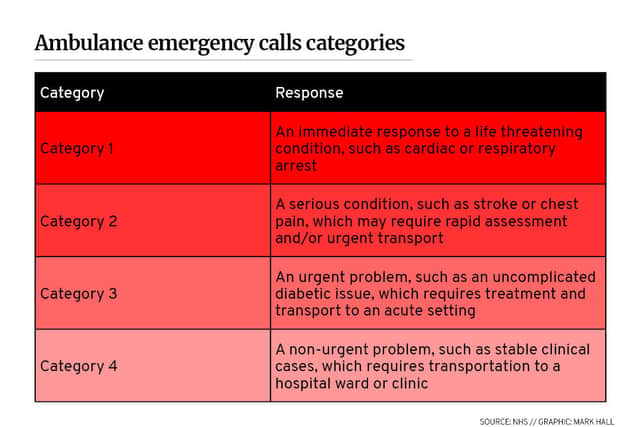Ambulance response categories: what are the 4 levels of accidents and emergencies for 999 call responders?
and live on Freeview channel 276
Ambulance staff are striking on 21 December, with plans in place for both staff and patients during industrial action. The most serious of accidents and emergencies will be prioritised based on the category they fall into, but what are these categories and what injuries or illnesses come under each category?
UNISON, Unite and the GMB have confirmed that members will take part in strike action on Wednesday 21 December 2022. GMB members will also take part in an additional strike day on Wednesday 28 December.
Advertisement
Hide AdAdvertisement
Hide AdStrikes on these dates will mainly impact NHS ambulance services. GMB members will strike in nine ambulance trusts, UNISON members will strike in five ambulance trusts and Unite members will strike in three ambulance trusts. UNISON also has a mandate for industrial action at Liverpool Heart and Chest Hospital NHS Foundation Trust and Liverpool University Hospitals NHS Foundation Trust, where strikes will also take place on 21 December.
What are the different categories?
There are four categories that 999 ambulance calls are put into. These are 1, 2, 4 and 4.
This is what each category means and advised response times:
Category 1
Calls from people with life-threatening illnesses or injuries.
- What does this mean? An immediate response to a life threatening condition, such as cardiac or respiratory arrest.
- Response time: 15 minutes.
Category 2
Emergency calls.
- What does this mean? A serious condition, such as stroke or chest pain, which may require rapid assessment and/or urgent transport
- Response time: 40 minutes.
Category 3
Urgent calls.
- What does this mean? An urgent problem, such as an uncomplicated diabetic issue, which requires treatment and transport to an acute setting.
- Response time: 2 hours.
Category 4
Less urgent calls.
Advertisement
Hide AdAdvertisement
Hide Ad- What does this mean? A non-urgent problem, such as stable clinical cases, which requires transportation to a hospital ward or clinic.
- Response time: 3 hours.


Which 999 calls will be prioritised during ambulance strikes?
Health minister Will Quince told the public that in any emergency calling 999 should still be the first option. He said the “key thing” is that for anybody that does have an emergency situation or a life-threatening situation “they continue to call 999 as they would have done previously, and for any other situation, NHS 111 or NHS 111 online”.
He said that anyone with chest pains on a strike day should still call 999. Negotiations between unions and ambulance services are ongoing to work out which incidents should be exempt from strike action.
It is expected that all category 1 calls, the most life-threatening such as cardiac arrest, will be responded to. Some ambulance trusts have agreed exemptions with unions for specific incidents within so-called category 2 which covers serious conditions, such as stroke or chest pain.
Why are ambulance workers striking?
Ambulance workers from the three unions are striking over a demand for a bigger pay increase than that decided earlier this year by the NHS pay review body. Health Secretary Steve Barclay and other ministers have said they are unwilling to go beyond the offer already made, which gives an average increase of 4.75% and a guaranteed minimum rise of £1,400 a year.
Comment Guidelines
National World encourages reader discussion on our stories. User feedback, insights and back-and-forth exchanges add a rich layer of context to reporting. Please review our Community Guidelines before commenting.
